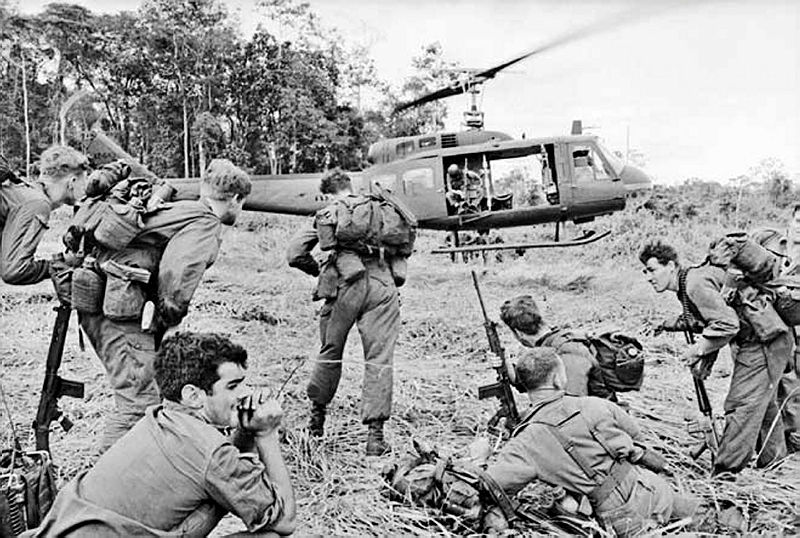A wartime alliance under strain—Vietnam 1967
Posted By Peter Edwards on May 4, 2017 @ 11:00

As President Trump and Prime Minister Turnbull prepare to mark the 75th anniversary of the Battle of the Coral Sea, and the centenary of the United States’ entry into World War I, we might also reflect on the 50th anniversary of another important, if less dramatic, stage in the wartime history of the Australian-American alliance. 1967 was a turning-point in the Australian government’s attitude to the Vietnam War, with important ramifications for American policy.
To persuade Washington to remain committed to the region, Australia had volunteered a battalion of combat troops in 1965, when the Americans had only been suggesting an increase in the number of advisers. Harold Holt’s impulsive exclamation on the White House lawn in June 1966 that Australia was ‘all the way with LBJ’ was also designed to strengthen American will.
After fighting the November 1966 election on the issues of the Vietnam War and conscription, Holt won what was then the biggest majority in Australia’s electoral history. With that public support, he began 1967 by committing additional units of the Army, RAN and RAAF, so that Australia become the only ‘third country’—that is, ally of South Vietnam and the United States—to provide forces from all three services.
Holt personally seemed inclined to increase Australia’s task force from two to three battalions, to the consternation of ministers and senior officials. They had supposed that Australia was following its established pattern of offering effusive rhetorical and diplomatic support to its major ally, but providing only the smallest number of boots on the ground necessary to convince Washington to remain committed.
As the year wore on, and the casualty lists of both regulars and conscripts lengthened, Australian public opinion on the war began to turn sour. The protest movement gained momentum, despite being divided into two clear wings. Moderates simply wanted an end to Australian involvement in a war that they considered unwinnable and unnecessary, while the radical ‘New Left’ portrayed the war and conscription as the products of a capitalist, parliamentary democracy whose institutions should be overthrown.
Those developments reflected major shifts in public opinion in the United States. In Washington, Johnson’s civilian and military advisers argued vehemently over Vietnam strategy. At the centre of the contest were requests from the American military commander, General William Westmoreland, for an increase in the American troop commitment. In a typical Johnsonian compromise, Westmoreland got part but not all of what he wanted. American troop numbers rose by about 100,000 during 1967, to their peak level of around half a million.
To secure additional troops from an increasingly hostile Congress, Johnson needed to show that the war had the whole-hearted support of its allies in the region. Johnson sent two of his most trusted advisers, Clark Clifford and Maxwell Taylor, on a July mission to secure more troops from allies such as Australia and New Zealand. Given Australia’s prominence as an outspoken hawk, they were optimistic, but they met unexpected resistance.
While battles raged in Parliament, in the media and on the streets about the war, conscription, the American alliance and Australian foreign policy, the Treasurer (and later Prime Minister) William McMahon was complaining of the growing burden of the war on Australia’s economy. So when Clifford and Taylor met the Australian Cabinet, Holt and his colleagues tried to persuade the Americans that Australia had already reached the limit of its capacity to contribute.
Only after Johnson had unleashed the full force of his persuasive powers on the unfortunate McMahon during a visit to Washington did the Holt government agree, extremely reluctantly, to commit a third battalion to the task force in Vietnam. That, they insisted, was the absolute limit of the Australian commitment. When Holt’s successor John Gorton announced during the Tet offensive in February 1968, that there’d be no further increase to the Australian force, many assumed that he was placing his personal imprimatur on a commitment that he had long questioned. In fact, he was stating publicly what the Holt government had privately decided, and had told the Americans, several months earlier.
Clark Clifford later wrote that he was struck by the fact that Australia, which had sent hundreds of thousands of armed men overseas in World War 2, was now reluctant to commit more than about 7,000 in Vietnam. This, he claimed, contributed to his own decision to turn American policy towards withdrawal when he served as Johnson’s last Defense Secretary in 1968, after Robert McNamara had resigned in a virtual admission that his Vietnam policy had failed.
From the end of 1967 onwards, the atmosphere within the Australian government over the Vietnam war was totally different from when the year began. The focus of attention became how to bring Australian troops home as the Americans withdrew theirs. Holt’s successors were caught between the escalating financial costs of the commitment and the political costs of an increasingly unpopular war. Public opinion polls in the US turned against the war in 1968 and in Australia in 1969, but the turning-point for the Australian government came in 1967.
Fifty years on, as we debate the possibilities of greater independence within the alliance, it’s worth remembering that, even in the war that is often cited as the classic example of Australia’s ties to American military might, we weren’t really ‘all the way with LBJ’.
Article printed from The Strategist: https://www.aspistrategist.org.au
URL to article: https://www.aspistrategist.org.au/wartime-alliance-strain-vietnam-1967/
Click here to print.